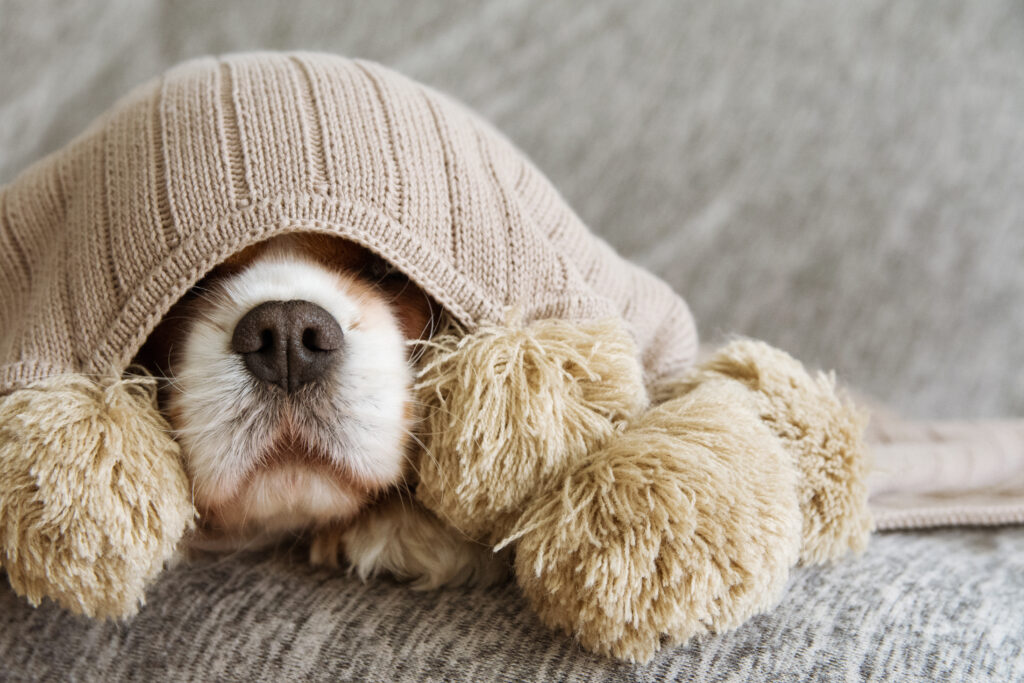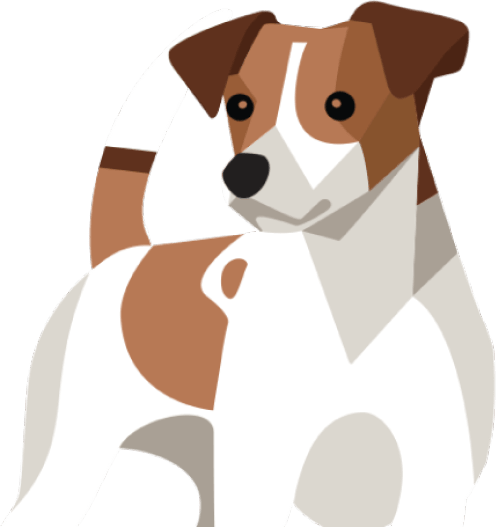
March is the official “pet anxiety awareness month” so here at Laughing Dog, we wanted to help educate dog owners on the signs of anxiety in their four-legged friends and ways of helping them cope with stressful situations.
While March is the month of awareness, dog anxiety can happen at any time of the year for a few different reasons. Even dogs who do not commonly suffer from anxiety can be affected by certain triggers. Commonly dog anxiety is caused by loud noises such as fireworks, visits to stressful environments such as the vets, changes in the home or separation anxiety when left for long periods of time or for any period outside their normal routine.
Signs of separation anxiety in dogs
Unless you have a doggy-cam setup, you are unlikely to know that your dog has been experiencing separation anxiety until you return home. But on your return, the signs will likely be obvious. Often dogs who experience separation anxiety may become destructive around the house. Chewing on items, particularly ones which have your scent on them. They are likely to be scratching at doors if locked in a certain area and frequently drink excessive water and possibly even toilet inside the home. Other dogs will bark and howl for you to come back and will appear agitated, will pant, and salivate more than usual, which will be noticeable on your return.
Is separation anxiety in dogs common?
Every dog reacts differently to stressful situations, some dogs are totally fine with the sound of fireworks and will sleep solidly through them, while others are quivering wrecks with pet owners dreading early November each year. This is the same with separation anxiety, some dogs are more resilient to being left alone than others. But this last year has been a huge change is doggy routines, which is likely to cause a spike in separation anxiety.
If pre-COVID you left your dog alone for your daily trip to the office without a second thought. After a long stint of working from home, your dog’s routine will have vastly changed, and they will have become much more reliant on your company. Many dogs who have been totally fine which being alone in the past are now more likely to experience separation anxiety.
While separation anxiety is common in dogs, there are steps that can be taken to help. If your dog has been used to being alone from a young age and they have a regular routine with plenty of interaction in between periods of being left alone, separation anxiety is likely to decrease.
How to help a dog with separation anxiety
We teamed up with Dr Louisa Graham to get some insider information on how to help your four-legged friends.
Try not to change their routine
“It’s important you don’t change your pet’s routine too much and make sure you try and keep their routine consistent. If they are used to spending a lot of time with you, then try and give them some alone time. Dogs need to feel comfortable being alone to prevent behavioural issues such as separation anxiety when our daily routines change again by returning to work. Before you become busier post-lockdown, then continue to give them that space so they are used to it when it is time for you to go. Try and leave them alone in the house for short periods and build it up over time – a great tip is to associate this down time with something positive like a treat.”
Add distractions
Another great tip is to provide your dog with distractions, when dogs are bored or lonely, they will create their own games which may lead to inappropriate and destructive behaviour.
When leaving the home many dog owners hide treats around their home or putting treats inside plastic bottles and cereal boxes for your dog to get out over time. The first 15-minutes of being on their own is usually the most critical time, so if this period is filled with distractions it can help calm your pooch, so they focus less on you leaving them.
Increase interactions
If you are aware your dog suffers from separation anxiety, try to increase your interactions with them, both before and after leaving them. Taking them for a good run around to get in some exercise before leaving them is a great way to tire them out, in hope that they will settle and sleep in your absence. Make sure you reward your pet on your return, with treats, interactive play, and plenty of fuss to express how well they have done on their own.
Dogs react well to positive reinforcement, so if the behaviour of reward and extra playtime with their favourite person comes after being alone, the idea of separation becomes less daunting for them.
What are the common causes of anxiety in dogs?
Anxiety in dogs usually stems from the fear of the unknown, or a trigger that is associated with a bad experience for them.
Commonly dogs experience anxiety for several things:
- Loud noises such as fireworks
- Being left alone
- Meeting new people
- Experiencing new places
- Travelling in cars
- Introduction of a new baby or pet
While the cause of anxiety in dogs might be very different, there are a lot of techniques that can help for all causes.
How to help a dog with anxiety
First and foremost, it is important to understand the trigger, if it is something which can be removed, then this will instantly help your dog. However, learning how to help your dog is also important, long term anxiety can be dangerous for a dog so understanding the signs and what to do is important for a long and happy life.
Positive reinforcement
Regardless of the cause, positive reinforcement works well on changing your pet’s behaviour. If meeting new people is a worry for your dog, for example, ensure your visitors do not interact with your dog until the dog is ready. Being naturally inquisitive, even the most timid or anxious of dogs will eventually get a little closer to your guest. At this time, make sure your visitor is poised with treats to encourage a positive message. This works for same for trips to the vets, loud noises or being left alone. Instilling reward and repetition for experiencing the stressful situation will eventually help over time.
Be prepared for no quick fix
There is no quick fix for anxiety in dogs and some dogs will never get over the fear of fireworks for example. In these situations, it is always best to just be there, create a safe environment for them and never leave them alone. Just your presence can really help to calm dogs’ nerves.
Spoiling them with soothing treats can also work wonders, Laughing Dog’s Sleep Tight treats are packed with soothing ingredients such as chamomile and ginger which can relax and calm your four-legged friend.
Allow your dog to go at its own pace
If you are introducing your dog to a new baby, new pet, new home, or environment, do not force it. Allow the dog to go at its own pace. If they retreat and hide, do not punish the behaviour as that will simply add to the negativity of the situation. Allow for calming assurance by not leaving them alone, take introductions gradually, short periods at a time, then reward with playtime and treats before introducing it again. The last thing you want to do is force their instinct of fight or flight, by forcing them to do something which upsets them.
Rewarding your dog
Not every dog is treat-driven, some see playtime as much of a reward as a tasty snack. Dr Louise Graham suggests trying nose games which are mentally stimulating and a great way to let your dog explore their natural sniffing abilities. Show your dog a treat and throw it, encouraging them to ‘fetch it/find it’. Then in time you can start hiding treats/toys around the garden or house encouraging them in the right direction where needed.
You should also encourage playtime, but not alone, play with them. Why not make an assault course to keep your dog occupied? This is where you can be creative. Use chairs to walk around/on, and towels/mops/pillows/rugs to walk over. If you have spare soil or bark for your garden, you could create a digging area and hide toys or treats in there for some supervised digging. If you do not have outside space, I would also recommend getting creative by putting cardboard boxes together, cutting holes in them to make-shift your own maze and tunnels.
Credit: Qualified vet, Dr Louisa Graham, has partnered Laughing Dog, the premium pet food brand, to offer guidance for pet parents to care for pets

